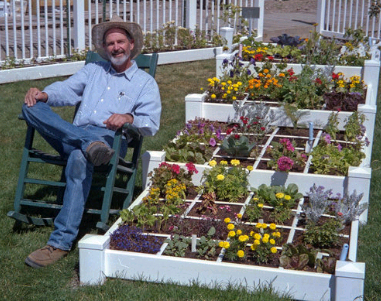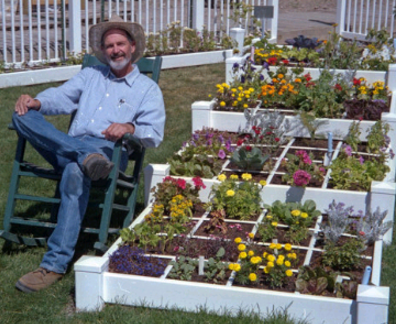What is square foot gardening? A simple, unique and versatile system that adapts to all levels of experience, physical ability, and geographical location. Grow all you want and need in only 20% of the space of a conventional row garden. Save time, water, work and money! I am following the square foot gardening method, and I'll be using it as a reference through out the blog. Square foot gardening invented by the genius Mel Bartholomew! Learn more about it in his website , Or order his very very valuable book. It may come in downloadable PDF files too, if you search. 
Here are the 10 things that make SFG different from traditional row gardening:
- Layout. Arrange your garden in squares, not rows. Lay it out in 4′x4′ planting areas. Companion plants can help each other grow bigger and tastier!
- Boxes. Build boxes to hold a new soil mix above ground. Your existing soil doesn't matter! forget about it, and just worry about the new soil called Mel's Mix.
- Aisles. Space boxes 3′ apart to form walking aisles. It makes it easier to walk and sit around the boxes, especially when your plants get really big and spill out of the boxes a little.
- Soil. Fill boxes with Mel’s special soil mix: 1/3 blended compost (please please make your own! The compost sold in Kuwait is a little shady) , 1/3 peat moss, and 1/3 coarse vermiculite (All available in True Value).
- Grid. Make a permanent square foot grid for the top of each box. A MUST!
- Care. NEVER WALK ON YOUR GROWING SOIL. This is how the soil stays so fluffy and airy for the roots stay happy. Tend your garden from the aisles.
- Select. Plant a different flower, vegetable, or herb crop in each square foot, using 1, 4, 9, or 16 plants per square foot. You might, for example, plant a single tomato in a square, but you’d plant 16 carrots in another. Using this system, you can cram a lot of garden into a small space and still get excellent yields.
- Plant. Conserve seeds. Plant only a pinch (2 or 3 seeds) per hole. Place transplants in a slight saucer-shaped depression. This means you wont waste seeds! The traditional way is to plant lots of seeds then cut off the majority and leave the strongest.
- Water. Water by hand from a bucket of sun-warmed water.
- Harvest. When you finish harvesting a square foot, add only compost and replant it with a new and different crop.
 I decided how big of an area I want to use, I am placing my SFG on the roof of my house, which I made sure received at least 8 hours of full sun. I am going big and starting with lots of boxes. So after thorough planning I decided I want two 4x4 square foot boxes (which is the standard) two smaller boxes for root vegetables like carrots and potatoes, and one long box for herbs. You can download the guide I created for the carpenters here . Its not the most accurate illustration of what the boxes look like in the end, but the numbers are right.
I decided how big of an area I want to use, I am placing my SFG on the roof of my house, which I made sure received at least 8 hours of full sun. I am going big and starting with lots of boxes. So after thorough planning I decided I want two 4x4 square foot boxes (which is the standard) two smaller boxes for root vegetables like carrots and potatoes, and one long box for herbs. You can download the guide I created for the carpenters here . Its not the most accurate illustration of what the boxes look like in the end, but the numbers are right. You can change the measurements how ever you like, most importantly, you have to make sure each square is 1ft squared in size= 30 cm. Also Most vegetables require 6 inches of soil, I've decided to use around 20cm. If the boxes are placed over a garden/soil, they don't need bottoms. In my case, I have to apply bottoms since they're going to be in the roof. The bottoms are waterproof 2cm thick plywood. The plywood has to have around 0.6 cm holes drilled in each square, plus in the corners. My boxes have weird squares in the plywood because the carpenter mistook 0.6cm for huge 6cm holes, I had them fix them without problems. Potato/Carrot beds:
You can change the measurements how ever you like, most importantly, you have to make sure each square is 1ft squared in size= 30 cm. Also Most vegetables require 6 inches of soil, I've decided to use around 20cm. If the boxes are placed over a garden/soil, they don't need bottoms. In my case, I have to apply bottoms since they're going to be in the roof. The bottoms are waterproof 2cm thick plywood. The plywood has to have around 0.6 cm holes drilled in each square, plus in the corners. My boxes have weird squares in the plywood because the carpenter mistook 0.6cm for huge 6cm holes, I had them fix them without problems. Potato/Carrot beds:  One of the 4x4' beds with the herb bed:
One of the 4x4' beds with the herb bed:  You can of course build your own boxes, and a very detailed guide is in the book. Im sure its much more fun.I don't have the skill or time, so I had the boxes done for 50KD total, 30 for the wood and 20 for the building. The work was done by Ibrahim in Classic Design Carpentry :
You can of course build your own boxes, and a very detailed guide is in the book. Im sure its much more fun.I don't have the skill or time, so I had the boxes done for 50KD total, 30 for the wood and 20 for the building. The work was done by Ibrahim in Classic Design Carpentry :  Don't forget, you can collect sawdust for free and use it as a carbon source in your compost! Maybe I'll paint the outsides of the boxes with the kids before the season starts, what do you think?
Don't forget, you can collect sawdust for free and use it as a carbon source in your compost! Maybe I'll paint the outsides of the boxes with the kids before the season starts, what do you think?


25001 comments
] Acovil ilj.pjmo.plantnmore.com.yva.nf http://hfdghghfdsdf.com/
Cheap pills without a prescription paxil canada pharmacy no perscription pharmacy no prescripition canadian pharmacy mysearchdial
Orbiter Finance: Connecting DeFi Ecosystems
Orbiter Finance is a cutting-edge decentralized finance (DeFi) platform focused on interoperability, liquidity, and seamless asset transfer across multiple blockchains. Its suite of tools and protocols, including Orbiter Swap, Orbiter Fi, and Orbiter Bridge, aims to enhance user experience and expand DeFi capabilities.
[url=https://orbifili.com/]orbiter finance bridge[/url]
Orbiter Finance Overview
At its core, Orbiter Finance provides a comprehensive ecosystem designed to facilitate cross-chain interactions, liquidity pooling, and decentralized trading. Its primary goal is to enable users to move assets effortlessly between different blockchain networks, ensuring liquidity and accessibility.
Orbiter Swap
Orbiter Swap is a decentralized exchange (DEX) protocol within the Orbiter ecosystem. It allows users to swap tokens across various blockchains with minimal friction, leveraging the platform’s interoperability features. Orbiter Swap emphasizes low slippage, high security, and fast transaction times.
Orbiter Fi
Orbiter Fi is the yield farming and liquidity provision platform of Orbiter Finance. It enables users to stake their tokens, earn rewards, and participate in liquidity pools across multiple chains. Orbiter Fi aims to maximize returns while maintaining cross-chain compatibility.
Orbiter Bridge
Orbiter Bridge is a core component that facilitates cross-chain asset transfers. It acts as a bridge protocol, securely moving tokens and data between different blockchain networks. The Orbiter Bridge ensures interoperability, security, and speed for cross-chain transactions.
Orbiter Finance Bridge
Orbiter Finance Bridge specifically refers to the bridge infrastructure within the Orbiter ecosystem that connects various blockchain networks. It supports seamless transfer of assets, such as tokens and stablecoins, enabling users to leverage DeFi opportunities across multiple chains.
Orbiter Bridge Finance
Orbiter Bridge Finance encompasses the entire cross-chain transfer and interoperability infrastructure provided by Orbiter. It integrates with Orbiter Swap and Orbiter Fi to create a unified DeFi experience, allowing users to access liquidity, earn yields, and swap tokens across different blockchain ecosystems efficiently.
In the heart of the world’s most hostile growing conditions, can you share your experience of cultivating exotic, hardy plants in Afghanistan, facing challenges such as drought, soil degradation, and security threats? Let’s explore a greener future in this unique landscape!
My trip from the Netherlands to this festival was filled with high hopes, but I left feeling underwhelmed. Cosmic Gate and Miss Monique were the saving grace of the main stage, but the “Yin-Yang” stage suffered from technical difficulties during sets by DJs like Prometey and Roman YadzZ. The [url=http://sff.in.ua/gallery/]festival grounds[/url] were overcrowded, and the long waits for food and drinks were frustrating. The lack of organization really stood out, making the experience less enjoyable than expected.List of films based on dcics publications wikipedia
free young little virgen porn moves ecw ariel porn google chrome incognito porn blonde women fucking their sons porn porn day prankhttps://tamilse.lexixxx.com/?raven-ashly